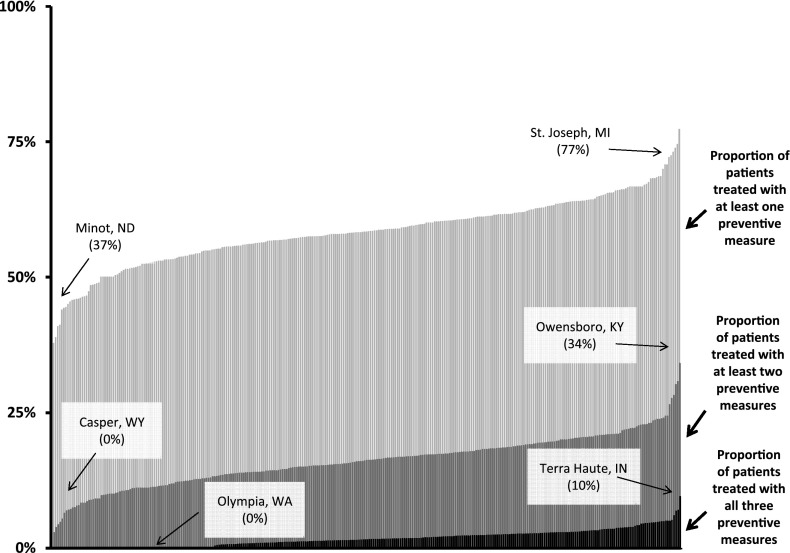When patients with diabetes and peripheral arterial disease (PAD) receive treatment for vascular disease, amputation rates tend to be lower, suggesting that greater utilization of vascular care is associated with lower amputation risk (1). However, procedural care is not provided in isolation. Patients should be engaged in a care system where preventive measures, such as hemoglobin A1c testing, podiatric care, and noninvasive vascular testing are routinely provided (2,3). However, it remains unknown how commonly patients at risk for amputation actually receive preventive measures. Therefore, we studied how commonly patients at risk for amputation actually receive evidence-based preventive measures aimed at limiting amputation.
We identified a cohort of 52,505 patients with diabetes and PAD in Medicare claims (2008–2009), who had been admitted to the hospital for an episode of lower extremity cellulitis. By design, these patients all had preexisting diabetes, PAD, and a hospital admission for leg cellulitis, and therefore were at high risk for amputation.
Within this cohort, we studied how commonly preventive measures, as recommended by the Healthcare Effectiveness Data and Information Set (HEDIS) as well as the American Diabetes Association (ADA), were provided, including hemoglobin A1c testing (1), diabetic foot examination (2), and noninvasive vascular testing (3). We studied the provision of these three measures during a 2-year window (a year before or after hospital admission) for each patient, using data from 2007–2010, both at the individual level and across hospital referral regions as defined in the Dartmouth Atlas of Health Care (4).
Overall, 59% of patients received at least one preventive measure. The most commonly provided preventive measure was hemoglobin A1c testing (30% of patients), followed by noninvasive vascular testing (28% of patients) and diabetic foot examination (21% of patients). In total, 42% of patients received one preventive measure in the year before or after hospital admission, 15% of patients received two of the three recommended preventive measures, and 2% received all three recommended preventive measures. When we aggregated patients by hospital referral regions, we found a twofold difference in the proportion of patients treated with at least one preventive measure, from a low of 37% in Minot, ND, to 77% of patients treated in St. Joseph, MI (Fig. 1). Low rates of preventive measure utilization, as well as similar rates of regional variation, were seen when we examined the proportion of patients treated with two or all three preventive measures.
Figure 1.
Proportion of patients treated with one, two, and all three preventive measures, by hospital referral region.
While observational and descriptive in nature, our analyses suggest that evidence-based, broadly recommended preventive measures are uncommonly provided to patients with diabetes, PAD, and limb-threatening tissue loss. Fewer than one in five received two of the three preventive measures, and strikingly few patients—less than 5% in both individual and regional analyses—received all three preventive measures recommended by HEDIS and ADA guidelines. Future quality efforts need to focus on improving the delivery of preventive aspects of care for patients with diabetes and PAD. Our study suggests these efforts should focus on patients at the highest risk for amputation.
Article Information
Funding. P.P.G. was supported by funding from the Society for Vascular Surgery Foundation and the National Heart, Lung, and Blood Institute (NHLBI 1K08HL05676).
Duality of Interest. No potential conflicts of interest relevant to this article were reported.
Author Contributions. P.P.G., A.M., E.L.S., and B.S.B. performed the research data. P.P.G. and A.M. wrote, reviewed, and edited the manuscript. A.M. contributed to the discussion. E.L.S., B.S.B., R.R.D., D.H.S., and B.W.N. contributed to the discussion and reviewed and edited the manuscript. P.P.G. is the guarantor of this work and, as such, had full access to all the data in the study and takes responsibility for the integrity of the data and the accuracy of the data analysis.
References
- 1.Goodney PP, Holman K, Henke PK, et al. Regional intensity of vascular care and lower extremity amputation rates. J Vasc Surg 2013;57:1471–1479.e1–e3; discussion 1479–1480 [DOI] [PMC free article] [PubMed] [Google Scholar]
- 2.National Committee on Quality Assurance. Managing Diabetes Complications: Recommendations from the National Committee on Quality Assurance. Available from http://www.ncqa.org/PublicationsProducts/OtherProducts/QualityProfiles/FocusonDiabetes/ManagingDiabetesComplications.aspx Accessed 15 January 2014
- 3.The American Diabetes Association Recommendations for foot care and amputation prevention. Available from http://www.diabetesforecast.org/2012/dec/top-tips-for-better-foot-care-with-diabetes.html Accessed 15 January 2014
- 4.The Dartmouth Atlas of Health Care [Internet], 2014. Hanover, NH, Dartmouth College Press. Available from www.dartmouthatlas.org Accessed 1 January 2014



